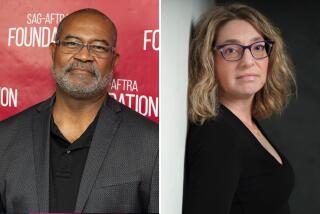Breaking the Glass Shield for Women
- Share via
STANFORD — It may be small comfort to the female deputies in the L.A. County Sheriff’s Department dealing with sexual harassment and discrimination on the job, as well as to county residents who pay court-imposed judgments, but a recent study of women in policing by the International Assn. of Chiefs of Police (IACP) shows they are not alone. The study aptly illustrates the difficulties that Sheriff Lee Baca and other police chiefs across the nation face in resolving this issue.
Baca took over a department that last year paid $661,000 to settle sexual-harassment claims. Under the new sheriff, the problem has continued. In March, he backed down from a plan to promote women to higher-paying patrol jobs after the deputy sheriffs’ union threatened to sue. The Assn. for Los Angeles Deputy Sheriffs also posted, then removed, a link to e-mail responses to Baca’s plan, some of them sexually graphic. Last month, county lawyers recommended paying $275,000 to a former deputy who claimed that fellow deputies had repeatedly asked her for dates and watched a raunchy video at a workstation nearby.
The IACP, made up of more than 14,000 police chiefs, found that women have won more than one-third of the sexual harassment lawsuits they filed against police departments. Other findings: 91% of the departments have no women in policymaking roles, and but 123 of the 17,000 police agencies in the United States have female chiefs. Only 12% of the country’s 600,000 police officers are women, and this proportion has not changed in 10 years.
Policing has always been a male-dominated occupation. In 1974, as police chief of Kansas City, I attended Major City Police Chiefs Assn.’s annual meeting, which represented the 25 largest cities. One chief told me he loved the policewomen in his department. He called them his “little powder puffs” and vowed never to expose them to the dangers of patrol. A few weeks later, his department’s policewomen’s association censured him for publicly making the same comments.
Another chief of a big-city department said that he would accept women in his force once he saw them compete in professional boxing or football. I knew he was wrong, because I had just come from the New York Police Department, which had lost a relevant suit brought by women officers. A court had rejected the department’s argument that women were not physically capable of performing police duties. A certain level of physical strength was required in policing, the court ruled, but the job certainly did not compare to professional athletics.
Similarly, courts have rejected minimum height standards, which had kept Latinos and Asians out of police forces, as not job-related. Some women, it turns out, are far stronger than a number of men accepted by police departments, and some short officers are far more adept physically than their taller counterparts.
Although macho chiefs have been forced to eat their sexist words, the old attitudes are still a major problem. Only 10% of the chiefs in the new IACP study said they believed that gender bias was among the reasons women were not promoted. It is reasonable to suspect that some of the respondents were not totally candid about this, and that a survey of rank-and-file officers, including women, would show a much greater awareness of the problem of discrimination.
Penny Harrington, director of the National Center for Women and Policing and former police chief of Portland, cites police unions as an obstacle to bringing women into the mainstream of policing. In 1976, when I became police chief in San Jose, I also found that the force’s labor organization, in accord with the views of its members, strongly resisted efforts to accommodate women officers. The department had been slapped with a discrimination suit for hiring females as “assistant policewomen.” The city settled under a consent decree and gave the women police-officer status. Some male officers didn’t like that. For example, racial and gender slurs were painted across the walls of the women’s locker room.
A short time later, two female officers told me that an officer had taken the podium at a briefing and told a joke about lesbians. Since they were the only two women in the room, all eyes turned on them, studying their reaction. It turned out that the duty captain had told the joke, the very officer I had instructed to prevent such remarks.
It took years to significantly lessen sexual harassment in the San Jose department. It helped that the mayor and City Council adamantly denounced it. This was most important because politicians are eager to receive the endorsement of police unions. When they hesitate to take a stand opposing the union on an important issue like harassment, it often encourages resistance in the ranks. The city hired outside counsel to provide training for all members of the department and made it clear that appropriate discipline would be taken for violations of policy.
Nevertheless, old perspectives die hard. There were not enough female officers to influence the union, and there were no female supervisors. Civil Service standards tend to be rigid. It took years to increase the number of female officers on the force, and the lack of women in upper ranks hindered both recruitment efforts and the internal commitment against harassment. Fortunately for San Jose, many female officers did eventually compete and did well on promotion exams. Women now hold every position from sergeant to deputy chief.
The police world can be hard and brutal. Police generally suffer higher than average rates of suicide, alcoholism, and stress and health disabilities. During my years in policing, I found that women officers introduced much-needed empathy into into a “John Wayne” male culture that refused to show emotion or acknowledge the human problems inherent in policing. Indeed, some of the vulgar and dysfunctional responses of male officers toward women were evidence that police managers need to do more to socialize officers into the outside community. Having a healthy percentage of women in the police ranks benefits both the public and the members of the police organization.
American police are not soldiers imposing martial law on the citizenry. They are peace officers sworn to protect the innocent. These are the ideals that draw women to policing. Cops can only be effective when they act as public servants and win the respect and cooperation of the neighborhoods they serve. Excluding or harassing women officers diminishes the reputation of the police, as a whole, and the inclination of citizens to report crime, serve as witnesses and believe police testimony when jurors.
The courts have ruled on constitutional grounds that women have an equal right to be police officers and to compete for promotions. Male officers who infringe on these rights by engaging in sexual harassment are not only unprofessional. They are also in violation of the first oath they took as police officers: To uphold the Constitution of the United States.
More to Read
Sign up for Essential California
The most important California stories and recommendations in your inbox every morning.
You may occasionally receive promotional content from the Los Angeles Times.









